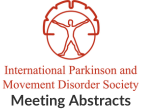Spinocerebellar ataxia (SCA) type 2 and type 8: a tale of two repeat expansions in a single patient
Objective: To describe the rare occurrence of coexisting SCA Types 2 and 8 in a pediatric patient. Background: SCAs are a group of autosomal dominant…Extracerebellar Signs and Symptoms in 117 Korean Patients with Early-Stage Spinocerebellar Ataxia
Objective: In this study, extracerebellar signs and symptoms in Korean patients with early-stage spinocerebellar ataxia were investigated. Background: Spinocerebellar ataxias (SCAs) are the most common…Hot cross bun sign in progressive ataxia with ELVOL4 mutation
Objective: To describe a case of progressive gait abnormalities and bulbar dysfunction which was associated with genetic mutation and neuroimaging findings representative of spinocerebellar ataxia…CEREBELLAR COGNITIVE AFFECTIVE SYNDROME IN SPINOCEREBELLAR ATAXIA TYPE 3
Objective: This preliminary study aims to examine whether motor and cognitive features in spinocerebellar ataxia type 3 (SCA3) are manifestations of a shared and parallel,…Spinocerebellar Ataxia Type 3 Presenting with Motor Neuron Disease
Objective: Spinocerebellar ataxia type 3 (SCA3) is associated with a wide spectrum of clinical manifestations, including peripheral neuropathy and amyotrophy, in addition to other motor…The genetic study of autosomal dominant spinocerebellar ataxia in Kazakhstan
Objective: To perform the genetic study of autosomal dominant spinocerebellar ataxia (ADSCA) cases from Kazakhstan. Background: Spinocerebellar ataxias (SCAs) is a large group of hereditary…Novel Mutation in the Protein Kinase C Gamma Gene Causing Spinocerebellar Ataxia-14 in a Large Family
Objective: To report a novel mutation not been previously reported in large, multi-ethnic general populations, in the protein kinase C gamma (PRKCG) gene causing spinocerebellar ataxia…Prevalence and Clinical Profile of Common Spinocerebellar Ataxia in Malaysia
Objective: To describe prevalence and demographics of Spinocerebellar Ataxia (SCA) 1,2,3,6 and 7, and the phenotypic characteristics of SCA 3 patients in Malaysia. Background: Spinocerebellar…An unusual phenotype of spinocerebellar ataxia type 12
Objective: To describe a case of spinocerebellar ataxia type 12 (SCA-12) with an unusual phenotype. Background: SCA-12 is a rare autosomal dominant cerebellar ataxia which…Amantadine Therapy for Ataxia Management in Patients with Spinocerebellar Ataxia Type 7
Objective: To report the therapeutic effects of amantadine in a patient with Spinocerebellar ataxia type 7 (SCA7) Background: Spinocerebellar ataxia type 7 is a rare…
- « Previous Page
- 1
- …
- 5
- 6
- 7
- 8
- 9
- …
- 14
- Next Page »
